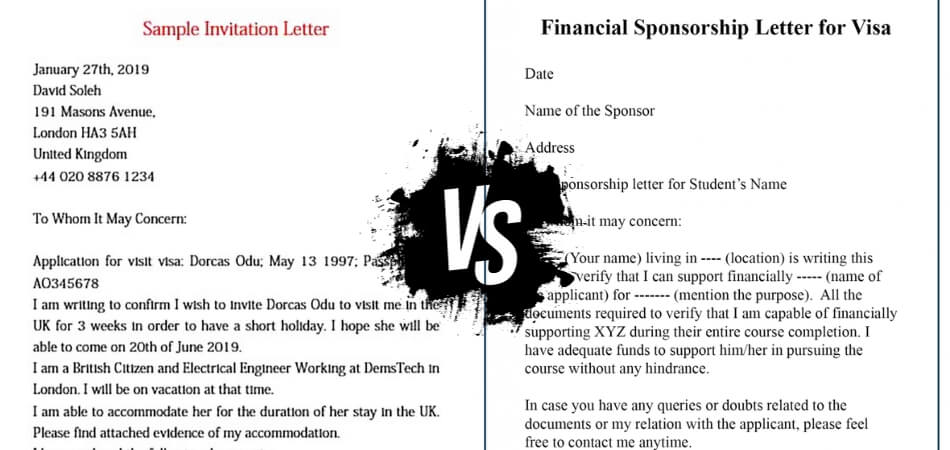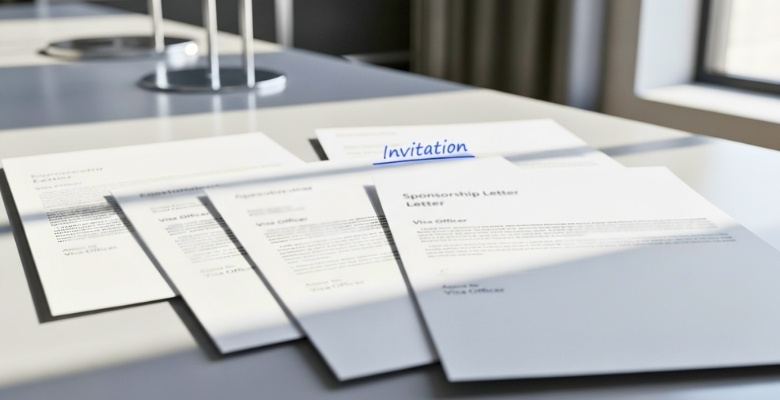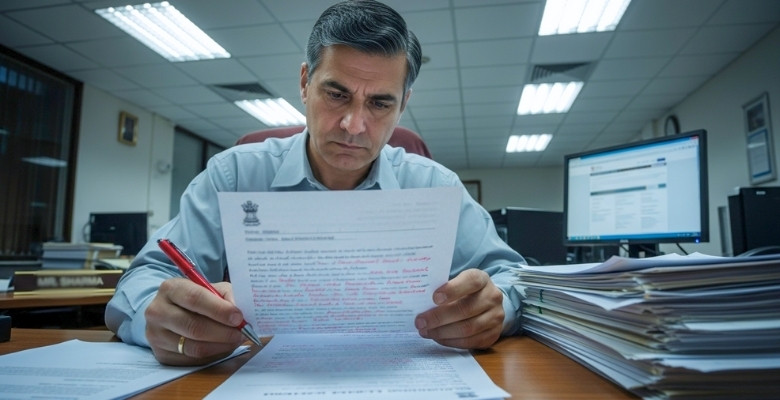When applying for a visa, familiarizing yourself with the types of supporting documents required is crucial for a successful application. There are two types of letters that are frequently requested: invitation letters and sponsorship letters. But what exactly sets them apart? What is the difference between an invitation letter and a letter of sponsorship for a visa application?
The main difference between an invitation letter and a letter of sponsorship is their purpose. An invitation letter serves as proof that the applicant has been invited by someone in the destination country, often for tourism, business, or events. In contrast, a letter of sponsorship guarantees that a sponsor will financially support the applicant during their stay, covering travel, lodging, and daily expenses.
Throughout this article, we’ll go over these documents in detail and help you pick the right one. So stay tuned.
What is the Difference Between an Invitation Letter and a Letter of Sponsorship for a Visa Application?
Visa applications can be smoother when you recognize the right documents. A letter of invitation and a letter of sponsorship are two important letters commonly required. When you know their differences, preparing the right paperwork becomes easier. Listed below are the differences between an invitation letter and a sponsorship letter:
Purpose of Each Letter
An invitation letter or letter of invitation shows that someone in the country you want to visit has invited you. It is often used for trips like tourism, family visits, or special events. The letter proves you have a real reason to travel and that someone is expecting you. It helps visa officers trust that your visit is genuine. The letter focuses more on the relationship and the purpose.
A letter of sponsorship shows that someone will pay for your stay and expenses. This person promises to cover costs like travel, food, and a place to stay. It is important when you don’t have enough money to prove you can support yourself. The letter gives visa officers confidence that your trip will be financially covered. It focuses more on money and financial support.
Who Can Write the Letter?
Letter of invitation or invitation letter is written by people like friends, family, or event hosts in the country you want to visit. These people share their details and explain why they want you to visit. The letter shows they welcome you and take responsibility for your visit. It must be honest and clear to avoid visa problems. The letter is usually personal and friendly.
Sponsorship letters are written by people or groups who can afford to pay for your trip. This might be a family member, employer, or organization. The sponsor needs to prove they have enough money to support you. They usually add documents like bank statements to prove this. The letter is more formal and focuses on financial support.
Required Information in the Letters
An invitation letter includes the inviter’s and visitor’s names, the visit reason, and how long you will stay. It also tells you where you will live while visiting. For example, if you’re applying with an invitation letter for UK visa, it should clearly show who is inviting you and why. This information helps the visa officer understand your trip better. Clear and correct details make the letter trustworthy. It should explain the visit’s purpose simply.
A sponsorship letter says who will pay for your trip and what costs they will cover. It gives details about the sponsor’s money and their relationship to you. The letter promises full financial support during your visit. This helps visa officers feel sure you won’t have money problems. The letter must clearly state the sponsor’s commitment.
Legal Importance and Verification
While a letter of invitation is useful, it does not guarantee that your host will cover your travel expenses. You might still be asked to provide proof of your own finances by visa officers. The main purpose of the letter is to prove that you have a real host and a clear reason to visit. In some countries, the letter may need to be stamped, notarized, or written on an official form, but in others, it is not required.
Sponsorship letters can carry more legal weight, but their importance also changes by country. In many places, it is only supporting evidence and not a legal promise. But in some countries, such as Germany and the Netherlands, sponsors must fill out an official form at the local authority. That form is legally binding, meaning the sponsor is responsible for your expenses. Because of this, visa officers carefully check the sponsor’s financial documents. A sponsorship letter or official form is very useful if you cannot show enough money on your own.
Impact on Visa Approval
An invitation letter helps your visa chances by showing you have a real reason to visit. It tells visa officers about your host and your visit plans. But if you don’t have proof of money, this letter might not be enough. Combining it with financial proof makes your case stronger. It is helpful, but not always enough.
A sponsorship letter improves visa approval when money is a concern. It shows officers you won’t be a financial burden during your trip. This letter is very important for longer or expensive visits. Good documents from your sponsor can make the visa process easier. It often increases the chance your visa will be accepted.
Differences in Format and Tone
The format of invitation letter usually sounds friendly and personal. They talk about your relationship with the inviter and your visit plans. The letter is simple and shows the host’s willingness to welcome you. It is easy to read and feels warm. This helps visa officers feel comfortable about your visit.
Sponsorship letters are more formal and serious. They focus on money and the sponsor’s promise to pay your expenses. The letter uses clear, official language and shows proof of money. It is often written like a business document. This makes visa officers trust the financial support.
What Each Letter Must Include?
Preparing an invitation or sponsorship letter for a visa application means paying close attention to key details. These letters help visa officers assess the purpose of travel and verify financial support. A clear and well-structured letter strengthens your application and reduces the risk of delays. Below is a breakdown of what each type of letter should include.
Invitation Letter – Must Include
- Host’s details
- Full name
- Address in the destination country
- Contact number and email
- Status in the country (citizen, permanent resident, visa type)
- Visitor’s details
- Full name as in passport
- Passport number
- Relationship to the host
- Visit details
- Reason for the visit (family, tourism, event, business, etc.)
- Dates of travel and how long you will stay
- Where you will stay (host’s home or another address)
- Host’s declaration
- A statement that the host is inviting you and welcomes you to stay
- Signature and date
(Optional: In some countries, the letter may need to be notarized or stamped.)
Sponsorship Letter – Must Include
- Sponsor’s details
- Full name
- Address and contact details
- Job or financial background
- Legal status in the country (citizen, permanent resident, etc.)
- Applicant’s details
- Full name as in passport
- Relationship to the sponsor
- Financial support details
- Clear statement that the sponsor will cover the costs
- Types of costs (flight, accommodation, food, medical insurance, daily expenses, etc.)
- Duration of support (entire stay or specific period)
- Proof of funds
- Bank statements, payslips, or proof of income
- Sometimes tax documents or employment letters
- Sponsor’s declaration
- A statement promising to take financial responsibility during the visit
- Signature and date
(In some countries, this must be done on an official sponsorship form, which is legally binding.)
Country-Specific Rules for Invitation Letters and Letters of Sponsorship
Rules for invitation and sponsorship letters are not the same in every country. Some places treat them as optional, while others make them a strict part of the visa process. Knowing the differences can save time and avoid mistakes. Keep reading to see how these rules work in different regions.
Canada
Visa officers often ask for an invitation letter when you are visiting family, friends, or attending a conference in Canada. The host must give full details like their address, contact information, job, and legal status in Canada. However, this letter does not mean the host is financially responsible for you. A sponsorship letter in Canada is only required for special visas, such as for parents and grandparents, where sponsors must meet income rules. For visitor visas, proof of your own money is still very important.
USA
Invitation letters are not a formal requirement for tourist visas in the USA. You may still include one to explain the reason for your visit, but it does not guarantee approval. Sponsorship letters are also not mandatory, though some applicants use Form I-134 (Affidavit of Support) to show financial help. Even with this, officers mainly review your own ties, funds, and purpose of travel. Both letters act as supporting documents but are not deciding factors.
UK
In the UK, invitation letters are helpful for visitor visas, especially if you are staying with a host. The letter must include details about your stay and your relationship with the host. A sponsorship letter is stronger here because the sponsor may also provide financial documents like bank statements or payslips. These documents prove that you will not be a burden during your visit. While not a legal guarantee, they carry good weight in the decision process.
Schengen
For Schengen countries, invitation and sponsorship letters can be very important. Some countries, like Germany and the Netherlands, require an official sponsorship form called a financial undertaking. This is signed by the local authorities and makes the sponsor legally responsible for your costs. If you stay with a host, an invitation letter may also be needed to confirm your accommodation. These official documents play a big role in visa approval in Schengen countries.
How to Request Someone to Write You an Invitation Letter?
Asking someone to write you an invitation letter might feel a little confusing at first. You may not know how to ask or what to say. But with the right approach, it can be simple and stress-free. Let’s look at how to do it the right way:
Choose the Right Person
Think about someone who truly knows you and lives in the country you want to visit. This person can be a friend, family member, or even an event organizer. Make sure they are okay with writing the letter for you. The person should also be able to give honest and clear details about their visit. Choosing the right person is the first and most important step. A strong connection makes the letter more trusted by visa officers.
Explain Why You Need It
After choosing someone, tell them why the invitation letter is needed. Let them know it’s for your visa, and it will support your application. Be honest and clear when you explain your situation. This helps them understand how important their help is. Make sure to talk in a kind and respectful way. When people know their help matters, they are more likely to say yes.
Share Visit Details
Give your host the full details about your visit. Tell them when you plan to arrive and how long you will stay. Also, let them know where you will stay and what you plan to do. This helps them write a complete and useful letter. The more details you give, the better the letter will be. It also shows that you’ve thought about your trip carefully.
Be Polite and Kind
Always use kind and simple words when you ask for help. Say please, thank you, and show that you’re truly grateful. Even if they say no, respect their choice. People are more likely to help when they feel respected and not forced. A polite request can make a big difference. Good manners always leave a good impression.
Offer Help with Letter
Not everyone knows how to write an invitation letter, so offering help is a good idea. You can give them a sample or a simple guide. Just remind them to change it to match their own words and style. This makes the task easier for them and shows you care. Helping them also shows you’re serious about your trip. It makes the process faster and smoother.
Give Enough Time
Don’t ask for the letter a day before your deadline. Try to ask at least two weeks before you need it. This gives your host time to write it without stress. It also gives you time to read it and check for any mistakes. Rushing only causes problems and pressure. Early planning shows you’re organized and respectful of their time.
Follow Up Gently
If they don’t reply in a few days, it’s okay to check back kindly. You can say something like, “Just checking in if you have time.” Don’t message too many times or sound upset. A soft reminder shows you’re serious but still polite. People often get busy, so a little follow-up helps. Always stay patient and thankful. Below is a sample invitation letter they can send you:
[Your Full Name]
[Your Address]
[City, State, ZIP Code]
[Email Address]
[Phone Number]
[Date][Recipient’s Full Name]
[Recipient’s Address]Subject: Invitation to Visit
Dear [Recipient’s Name],
I hope this message finds you well. I would like to warmly invite you to visit me in [City/Country] from [Start Date] to [End Date]. It would mean a lot to spend time together and share special moments during your stay.
You are welcome to stay with me at my home located at [Full Address], and I will be glad to help arrange everything you might need during the visit. Please let me know if you are able to come, so we can plan the details in advance.
Thank you for considering my invitation. I look forward to your positive reply and to the chance of seeing you soon.
With warm regards,
[Your Signature]
[Your Printed Name]
Best Practices for Writing a Sponsorship Request Letter
Writing a sponsorship request letter is about being clear, polite, and direct. You need to show why your request matters and why the sponsor should support you. A well-written letter explains your needs while also respecting the sponsor’s time. Let’s look at some simple ways to do it right.
Clear introduction
Start with a short and polite greeting that shows respect to the sponsor. Tell them who you are and why you are writing. Avoid long background stories that make the letter confusing. Keep it short, warm, and to the point.
Purpose of request
Explain clearly why you are asking for sponsorship. Be honest about the event, trip, or program that needs support. Mention the dates and location so the sponsor knows exactly what it involves. A simple purpose builds trust and shows seriousness.
Sponsor’s benefit
Sponsors want to know how their support will be valued. Tell them what they will gain, such as visibility, recognition, or goodwill. Even small benefits should be explained simply and clearly. This makes your request more attractive and fair.
Financial details
Be specific about what kind of support you need. Mention if you are asking for money, travel costs, or accommodation help. Break it down in clear terms so there is no confusion. Sponsors prefer when requests are exact, not vague.
Attach supporting info
Add documents that give more details, such as event brochures, personal profiles, or schedules. These papers help the sponsor see that your request is genuine. Do not overload them with too many pages. Keep it clear, simple, and organized.
Respectful closing
End the letter by thanking the sponsor for their time and consideration. Invite them to contact you for any questions. Share your phone number or email so they can reply easily. Always sign the letter properly with your full name. Below is a sample of a sponsorship request letter:
[Your Full Name]
[Your Address]
[City, State, ZIP Code]
[Email Address]
[Phone Number]
[Date][Sponsor’s Full Name or Company Name]
[Address]
[City, State, ZIP Code]Subject: Request for Sponsorship
Dear [Sponsor’s Name],
I am writing to request your kind support for [state purpose, e.g., attending a conference, program, or event], which will take place from [start date] to [end date] in [location]. This opportunity is important for me, and your sponsorship would help make my participation possible.
Your support would cover [mention costs like travel, accommodation, or registration fees]. In return, I will be glad to [state benefit for sponsor, such as recognition, logo placement, or mention in materials]. I have included more details about the event for your review.
Thank you very much for considering my request. Please feel free to contact me at [phone number] or [email address] if you need any more information. I look forward to your positive response.
Sincerely,
[Your Signature]
[Your Printed Name]
Types of Short Invitation Letters and Letters of Sponsorship Written to a Visa Officer
When applying for a visa, the right letter can make your purpose clear to the visa officer. Invitation letters explain the reason for the visit, while sponsorship letters show financial support. Below are short sample letters you can use as a guide.
Invitation Letter Samples
- Family Visit Invitation Letter
[Your Full Name]
[Your Full Address in Host Country]
[Phone Number / Email]
[Date]
To: Visa Officer
[Embassy/Consulate Address]
Subject: Invitation for [Visitor’s Full Name]
Dear Sir/Madam,
I am writing to invite my [relationship, e.g., father, mother, sister] [Visitor’s Full Name, Passport Number] to visit me in [City, Country]. The purpose of the visit is family time and sightseeing. The visit will take place from [start date] to [end date].
During this stay, [Visitor’s Name] will live with me at my home address mentioned above. I will ensure proper accommodation and care during the stay.
Sincerely,
[Signature]
[Host’s Full Name]
- Tourist Visit Invitation Letter
[Your Full Name]
[Host’s Address]
[Phone/Email]
[Date]
Dear Visa Officer,
I would like to invite my friend [Visitor’s Full Name, Passport Number] to visit me in [City, Country] for tourism. We plan to visit popular places such as [list tourist spots]. The visit will be from [date] to [date].
My friend will stay with me at my home during the visit. I confirm that I welcome and support this visit.
Kind regards,
[Signature]
[Host’s Full Name]
- Business Invitation Letter
[Company Letterhead if available]
[Company Address]
[Phone/Email]
[Date]
To: Visa Section, [Embassy Name]
Subject: Business Invitation for [Visitor’s Full Name]
Dear Sir/Madam,
On behalf of [Company Name], I invite [Visitor’s Full Name, Passport Number, Job Title] to attend business meetings at our office in [City, Country]. The purpose of the visit is to discuss [project/business topic].
The planned visit is from [date] to [date]. Accommodation will be arranged at [hotel/company housing].
Sincerely,
[Authorized Person’s Name]
[Job Title]
- Event/Conference Invitation Letter
[Organization Letterhead]
[Organization Address]
[Phone/Email]
[Date]
Dear Visa Officer,
We are pleased to invite [Visitor’s Full Name, Passport Number] to attend the [Name of Event/Conference] held at [Venue, City, Country] from [date] to [date].
[Visitor’s Name] will be a [speaker/participant/guest] at this event. We confirm that the event schedule and accommodation details have been shared with the visitor.
Best regards,
[Authorized Signatory]
[Position]
Sponsorship Letter Samples
- Family Sponsorship Letter
[Your Full Name]
[Address]
[Phone/Email]
[Date]
Dear Visa Officer,
I, [Sponsor’s Full Name, Passport/ID], am sponsoring my [relationship] [Visitor’s Full Name] for their trip to [Country]. I will cover all expenses, including flight, food, accommodation, and travel insurance.
I am employed as [Job Title] at [Company Name]. Attached are copies of my bank statements, payslips, and proof of employment.
Sincerely,
[Signature]
[Sponsor’s Full Name]
- Business Sponsorship Letter
[Company Letterhead]
[Address]
[Date]
To: [Embassy/Consulate]
Subject: Sponsorship for [Visitor’s Full Name]
This is to confirm that [Company Name] will fully sponsor [Visitor’s Full Name, Passport Number] to attend [meeting/training] in [City, Country] from [date] to [date].
Our company will cover airfare, hotel, meals, and other related costs. Please find attached our company registration and financial documents.
Sincerely,
[Authorized Person’s Name]
[Job Title]
- Organization Sponsorship Letter (Conference/Event)
[Organization Letterhead]
[Address]
[Date]
Dear Visa Officer,
We are sponsoring [Visitor’s Full Name] to attend [Event/Conference Name] in [City, Country]. Our organization will take care of all expenses, including travel, stay, meals, and event fees.
Attached is proof of our organization’s financial ability and event details. We request that the visa be granted to allow participation.
Sincerely,
[Authorized Signatory]
[Position]
- Student/Training Sponsorship Letter
[Institution/Company Letterhead]
[Address]
[Date]
Dear Visa Officer,
This is to confirm that [Sponsor’s Name/Institution] will sponsor [Applicant’s Full Name] for the training/study program in [City, Country]. The sponsorship covers tuition, housing, travel, and daily expenses.
We have attached financial statements and relevant documents to support this sponsorship.
Sincerely,
[Authorized Person’s Name]
[Title/Position]
How to Submit an Invitation Letter and Letter of Sponsorship for a Visa Application?
Simply having the correct invitation letters is insufficient when applying for a visa. You also need to know how to submit them the correct way. Doing it right can improve your chances and make the process much smoother. Let’s take it step by step so you can be confident when it’s time to send your documents.
Step 1: Check the Visa Requirements
Before doing anything, always check what the visa office or embassy asks for. Some embassies may need original letters, while others accept scanned or printed copies. You can find these details on their official website or by calling the visa center.
Step 2: Choose the Right Format
Letters should be typed and printed on clean white paper. If the inviter or sponsor belongs to a business or organization, it’s better to use letterhead if possible. Make sure the letter is signed with a pen and dated clearly. Don’t use handwritten letters unless the embassy says it’s okay. Always keep extra copies for your records.
Step 3: Gather Supporting Documents
Don’t send the letter alone. Attach documents like passport copies, ID cards, bank statements, or proof of relationship depending on what the embassy asks. These extra papers help the visa officer believe the letter is real and trustworthy. If your sponsor is paying for the trip, include their financial proof too. The more complete your file is, the better your chances.
Step 4: Attach to Visa Application
Put the invitation or sponsorship letter together with your visa application forms. You can place it in the same envelope or upload it online if the embassy has an online system. When submitting paperwork in person, make sure to include the letter in the proper section of your file. Label it clearly so it’s easy to find. Don’t leave it loose or unmarked.
Step 5: Follow Country-Specific Rules
Some countries need the letter to be stamped, notarized, or done on official forms. For example, Germany may ask for a signed sponsorship form from their local office. The UK might accept a simple letter, but they also want proof like payslips. Always read the rules for the country you are visiting. Doing it right for that country helps avoid delays.
Step 6: Submit on Time
Timing is very important when it comes to visa letters. Make sure the letter is dated recently, usually within the last 3 months. Submit your full application, including the letter, before the deadline or visa interview. If you send it too late, they might ignore it. Early submission gives you time to fix any problems if needed.
Step 7: Keep a Backup
Always keep a copy of everything you send, including the invitation or sponsorship letter. Save both a printed version and a digital one, just in case you need to resend or show it again. If you are traveling with a copy, bring it in your hand luggage. A backup is extremely useful in case your documents disappear.
Top Errors in Invitation and Sponsorship Letters That Get Applications Refused
Mistakes in these letters can make a visa officer doubt your application. Invitation letters prove your visit’s purpose, while sponsorship letters show financial support. Below are common errors for each type that can lead to visa refusal.
Invitation Letter Errors
- Missing personal details: If the visitor’s full name or passport number is missing, the letter looks incomplete and raises doubts about the identity provided.
- Unclear relationship stated: Without explaining how the host knows the visitor, officers may question whether the visit is genuine or simply made up.
- No travel dates given: A letter without start and end dates appears vague, leaving officers unsure about the exact length of stay in the country.
- Address not mentioned: When the host’s full address is left out, officers cannot confirm where the visitor will live, weakening the overall application.
- Purpose not explained clearly: If the reason for the visit is too general or not stated, the officer may see the trip as unnecessary or suspicious.
Sponsorship Letter Errors
- Financial support not explained: If the sponsor doesn’t clearly state what costs they will cover, the officer may assume support is unreliable or incomplete.
- No documents attached: Submitting the letter without proof, such as bank statements or payslips, makes it easy for officers to doubt financial ability.
- Informal or weak wording: A very casual letter that doesn’t follow a formal style may look untrustworthy and fail to convince visa officers properly.
- Late submission of documents: If the sponsorship letter arrives after the application is reviewed, the officer may ignore it, risking refusal of the visa.
- Sponsor details incomplete: Leaving out the sponsor’s job, address, or legal status makes the letter weak and less convincing to immigration officers.
Frequently Asked Questions
When applying for a visa, many people feel unsure about which documents to prepare. Invitation and sponsorship letters are two that often cause confusion. These FAQs help clear up common questions and provide new details to guide you through the process.
Can I Submit Both Letters Together?
Yes, you can submit both an invitation letter and a sponsorship letter if needed. This can make your visa application stronger by showing both your travel purpose and financial support. Including both may be helpful for long trips or when the visa officer asks for extra proof. Just make sure the details in both letters match your application.
Can a Business Send an Invitation Letter?
Yes, a company or business can send you an invitation letter for visa purposes if your visit is for work or a business event. These letters usually mention the reason for your visit, event dates, and your role. They are more formal and help prove your business ties. Always request it on company letterhead for a professional look.
What Happens If the Sponsor Cancels Support?
If a sponsor withdraws their support, you will need to show your own financial proof to continue with your visa. This can affect your chances if your application depends on their money. Not telling the embassy about the change may also cause problems in the future, including possible refusals. The safest step is to inform the visa office right away and provide updated documents.
Can the Same Person Be a Host and Sponsor?
Yes, the same person can act as both your host and your sponsor if they are inviting and supporting you financially. In this case, they must write a letter that covers both parts clearly. This helps avoid confusion during your application. The person should also submit strong proof of income.
What if My Sponsor Is Retired?
A retired sponsor can still support you if they have enough savings or regular income, like a pension. They must show proof, such as bank statements or pension slips. Visa officers will check if they can afford your stay. Retirement doesn’t stop someone from being a valid sponsor.
How Long Should These Letters Be?
These letters do not need to be very long. A clear and direct letter of one or two pages is usually enough. The important thing is to include all the needed details like dates, names, and purpose. Long letters may confuse visa officers, so simple is best.
Can I Handwrite the Letters?
Handwritten letters are sometimes accepted, but typed letters look more formal and are easier to read. Most embassies prefer typed letters on a computer. If you must handwrite, make sure it’s very neat and clear. Avoid errors and use a pen, not a pencil.
What If My Host Lives in a Rented Home?
If your host lives in a rented place, they can still invite you. They just need to mention it in the letter and provide a copy of their rental agreement. This shows the visa officer that your stay is planned and legal. Hosts don’t have to own the home.
What Language Should the Letters Be in?
The letters should be written in the language accepted by the embassy, usually English or the country’s official language. If the letter is in another language, you may need to include a translation. Always check the embassy’s language rules before submitting. Translations should be official and clear.
Conclusion
Visa applications can feel overwhelming, but understanding which documents you need makes everything much smoother. Having the right support papers saves time, reduces stress, and increases your chances of approval.
If you’ve ever wondered what the difference is between an invitation letter and a letter of sponsorship for a visa application, remember that an invitation letter is about showing that someone in the country is inviting you for a visit. A sponsorship letter, on the other hand, shows that a person or organization will cover your expenses, making sure you won’t face money problems during your stay.
Picking the right letter for your visa type can make a real difference. Well-prepared documents show you’re serious about your travel plans and help visa officers trust your application even more!












